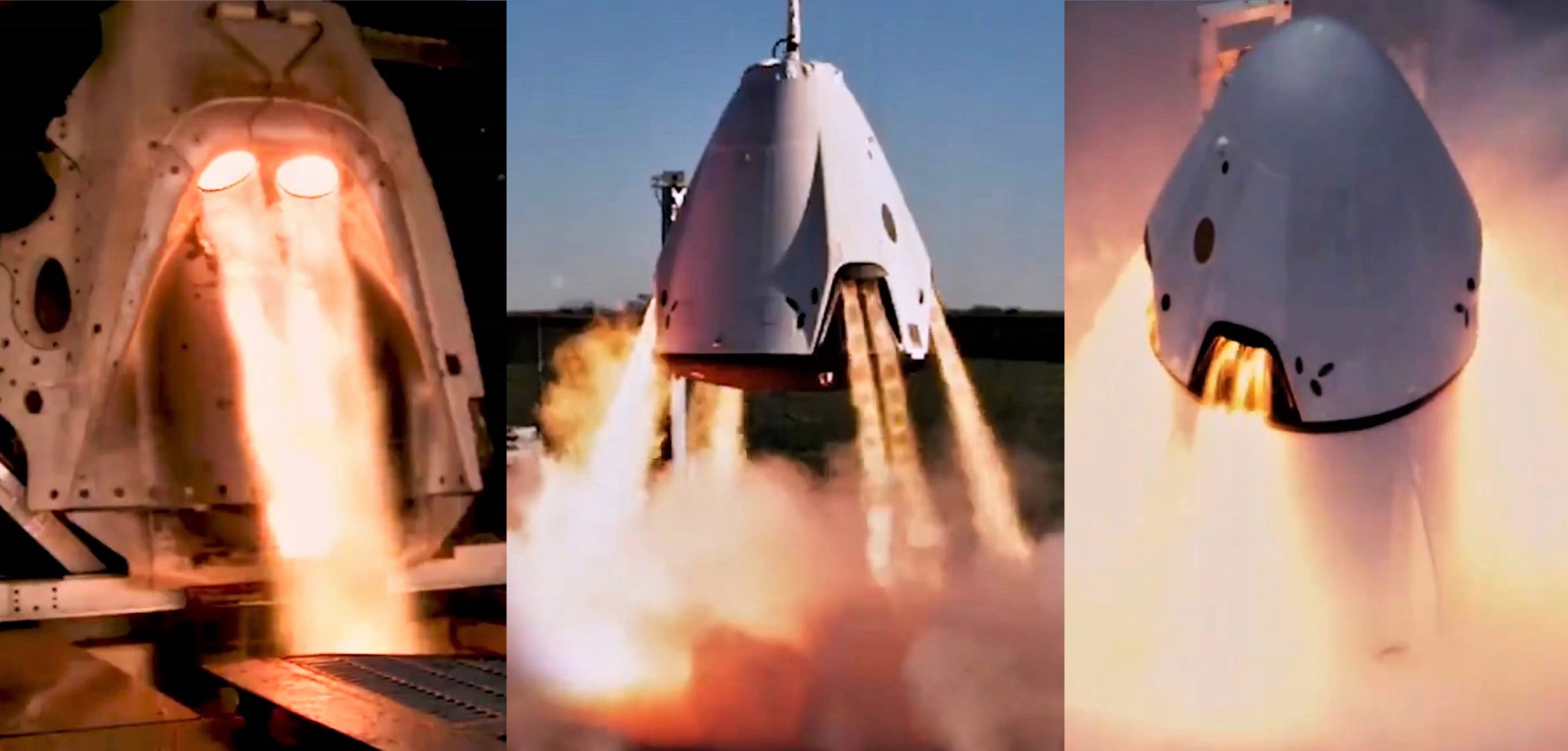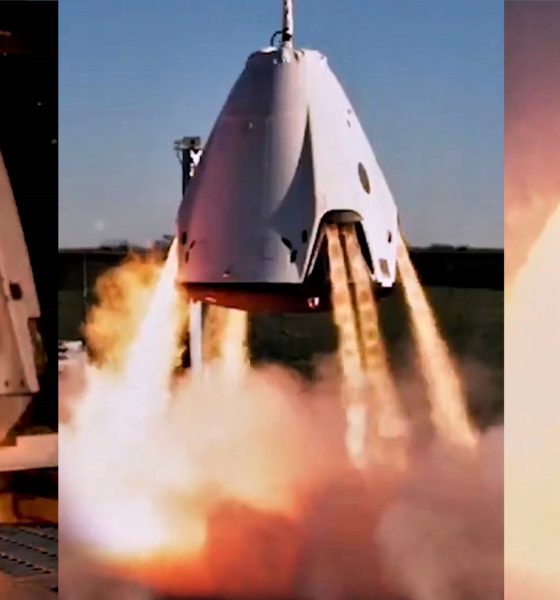

News
SpaceX aims to launch critical Crew Dragon abort test before the end of 2019
SpaceX has applied for an FCC Special Temporary Authority license to authorize rocket communications during what is likely Crew Dragon’s In-Flight Abort (IFA) test, now scheduled to occur no earlier than November 23rd.
In line with recent comments from SpaceX executives, a November or December In-Flight Abort test would almost certainly preclude Crew Dragon from launching with astronauts in 2019, pushing the Demo-2 mission into the Q1 2020. Nevertheless, it would serve as a good sign that Crew Dragon remains on track if SpaceX can complete the critical abort test – meant to prove that Dragon can whisk astronauts away from a failing rocket at any point during launch – before the year is out.
The FCC application describes “SpaceX Mission 1357” launch from NASA’s Kennedy Space Center (KSC) Launch Complex 39A, leased by SpaceX and primarily dedicated to launches involving either Falcon Heavy or Crew Dragon. Most tellingly, the STA request describes the mission as involving a “simulated orbital second stage”, an unusual phrase for SpaceX applications that almost certainly reveals it to be Crew Dragon’s IFA.
In the history of Falcon 9, all booster launches from Florida or California have carried functional Falcon upper stages. The FCC application’s “simulated” descriptor implies that this particular mission’s upper stage will not actually be capable of flight – a fact Elon Musk confirmed for the In-Flight Abort test in February 2019. Although the upper stage will otherwise be orbit-capable, the stage on Crew Dragon’s abort test is never meant to ignite and will thus feature a mass simulator in place of a functioning Merlin Vacuum (MVac) engine. A flight-proven Falcon 9 Block 5 booster – likely B1046.4 – will power the mission and both it and the upper stage are very unlikely to survive.
During the In-Flight Abort test, the Falcon 9 stack will lift off like any other launch, flying for approximately 60-70 seconds on a normal trajectory. Shortly thereafter, during a period of peak aerodynamic stress known as Max-Q, Crew Dragon’s SuperDraco abort system will somehow be triggered, causing the spacecraft to rapidly speed away from what it perceives to be a failing rocket. As Crew Dragon departs its perch atop Falcon 9’s upper stage, the rocket’s top will be instantly subjected to a supersonic windstream, akin to smashing into a brick wall. If the upper stage is quickly torn away, the booster will find its large, hollow interstage subjected to the same windstream, likely tearing it apart. The mission will undoubtedly be a spectacle regardless of how things transpire.

This filing comes ahead of the imminent resolution of a multi-month investigation to determine the cause of an anomaly that resulted in the loss of the DM-1 Crew Dragon capsule during a static fire test in April 2019. With that investigation nearly wrapped up and the Florida Department of Environmental Protection declaring “no further action” required with clean up efforts, as reported by Florida Today, SpaceX is likely ready to begin prelaunch preparations for Crew Dragon’s next major milestones.
SpaceX recently posted a video highlighting extensive testing of Crew Dragon’s SuperDraco abort system, noting the thrusters’ ability to propel a Crew Dragon capsule half a mile away from a failing rocket in just 7.5 seconds. SpaceX has performed more than 700 successful static fires, ranging from individual double-engine powerpack tests to a 2015 pad-abort test and integrated hover testing before propulsive Crew Dragon landing development was canceled in 2017.
The late-2019 IFA launch window means that a 2019 crewed Dragon debut is more or less impossible. Nevertheless, if SpaceX can successfully complete Crew Dragon’s IFA test in November or December, chances are good that there will be opportunities to attempt Crew Dragon’s crewed launch debut sometime in Q1 2020.
Check out Teslarati’s Marketplace! We offer Tesla accessories, including for the Tesla Cybertruck and Tesla Model 3.

Elon Musk
Elon Musk just said some crazy stuff about the Tesla Roadster

Elon Musk appeared on the Moonshots podcast with Peter Diamandis today to discuss AGI, U.S. vs. China, Tesla, and some other interesting topics, but there was some discussion about the upcoming unveiling of the Roadster, the company’s electric supercar that will arrive several years after it was initially slated for release.
Musk made some pretty amazing claims about the Roadster; we already know it is supposed to be lightning-fast and could even hover, if Tesla gets everything to happen the way it wants to. However, the car has some pretty crazy capabilities, some of which have not even been revealed.
On the podcast, Musk said:
“This is not a…safety is not the main goal. If you buy a Ferrari, safety is not the number one goal. I say, if safety is your number one goal, do not buy the Roadster…We’ll aspire not to kill anyone in this car. It’ll be the best of the last of the human-driven cars. The best of the last.”
🚨 Elon on the Roadster unveiling, scheduled for April 1:
— TESLARATI (@Teslarati) January 6, 2026
Musk makes a good point: people who buy expensive sports cars with ridiculous top speeds and acceleration rates do not buy them to be safe. They hope they are safe in case of an emergency or crash, but safety is not at the forefront of their thoughts, because nobody buys a car thinking they’ll crash it.
The Roadster is truly going to push the limits and capabilities of passenger vehicles; there’s no doubt about that. Tesla plans to show off the new version car for the first time on April 1, and Musk has only hinted at what is possible with it.
Musk said back in November:
“Whether it’s good or bad, it will be unforgettable. My friend Peter Thiel once reflected that the future was supposed to have flying cars, but we don’t have flying cars. I think if Peter wants a flying car, he should be able to buy one…I think it has a shot at being the most memorable product unveiling ever. [It will be unveiled] hopefully before the end of the year. You know, we need to make sure that it works. This is some crazy technology in this car. Let’s just put it this way: if you took all the James Bond cars and combined them, it’s crazier than that.”
Production is set to begin between 12 and 18 months after the unveiling, which would put the car out sometime in 2027. Hopefully, Tesla is able to stay on track with the scheduling of the Roadster; many people have been waiting a long time for it.
News
Tesla launches hiring for Robotaxi program in its twentieth country
Overall, the hiring signals Tesla’s aggressive timeline for global dominance in autonomous mobility.

Tesla has launched a hiring initiative for its Robotaxi program in its twentieth country, as the company posted two new jobs in Thailand this week.
Tesla is hiring in Bangkok and Kowloon for the Vehicle Operator position, which is related to data collection, and is the first in Thailand, but the twentieth country overall, as the company tries to expand into other markets.
🚨 BREAKING: Tesla is hiring additional full-time Vehicle Operators in Bangkok, Thailand.
Previous openings were 6-month, part-time roles. These are equivalent to AI Safety Operator roles in the U.S. pic.twitter.com/R6LzoU1bos— Tesla Yoda (@teslayoda) January 5, 2026
Tesla has had active job postings for Vehicle Operator positions in the United States, India, Israel, Taiwan, Germany, the Czech Republic, Hungary, the UK, Finland, Switzerland, Sweden, the Netherlands, Austria, Spain, Norway, Italy, and Turkey in past listings.
These postings are not all currently available, likely because the roles have been filled.
Thailand is the most recent, and broadens the company’s potential path to expanding its ride-hailing program, which is only active in the United States in Austin, Texas, and the California Bay Area, so far.
These roles typically involve data collection, which assists in improving Autopilot and Full Self-Driving operation. Tesla’s self-driving programs utilize real-world data that is accumulated and stored, observing vehicle and traffic behavior, as well as tendencies that are performed by human drivers to help increase safety and overall performance.
Overall, the hiring signals Tesla’s aggressive timeline for global dominance in autonomous mobility. Although the company has several high-profile rivals and competitors in the field, it has established itself as a main player and a leader in the development of autonomous technology, especially in the U.S., as its FSD suite is refined on almost a weekly basis.
The Full Self-Driving suite is available in seven countries and territories currently, including the U.S., Canada, China, Mexico, Puerto Rico, Australia, and New Zealand. Its biggest goal for expansion is currently the European market, where regulatory hurdles have been the main bottleneck prolonging its launch on the continent.
Tesla has performed months of testing in various European countries, including France and Spain, and does have support in some areas from various regulatory agencies. However, the company is hoping to get through this red tape and offer its suite in Europe for the first time, hopefully this year.
News
Tesla China rolls out Model Y upgrades, launches low-interest financing
These strategies are aimed at improving the ownership experience and keeping vehicle pricing competitive in the world’s largest electric vehicle market.

Tesla has rolled out minor updates to the five-seat Model Y in China, upgrading the vehicle’s center display to a higher-resolution 16-inch 2K screen. The electric vehicle maker also introduced attractive financing options, including 7-year low-interest rates, to offset the new purchase tax on EVs.
These strategies are aimed at improving the ownership experience and keeping vehicle pricing competitive in the world’s largest electric vehicle market.
Five-seat Model Y gets larger, better display
With its recent update, all three variants of the five-seat Model Y now feature an upgraded 16-inch 2K resolution center display, which replaces the vehicle’s previous 15.4-inch 1080p panel. This screen was already used in the six-seat Model Y L, and it offered improved visual clarity. Tesla China has also updated the Model Y’s headliner to black, giving the vehicle a sleeker appearance.
Prices of the five-seat Model Y remain unchanged at RMB 263,500, RMB 288,500, and RMB 313,500 for the respective trims. This update enhances the cabin experience as domestic rivals are already adopting high-resolution screens. As noted in a CNEV Post report, some domestic automakers have begun rolling out vehicles equipped with 3K-resolution displays.
New financing offers
Tesla also launched ultra-long-term financing offers for its locally produced models in China, which include the Model 3 sedan, the five-seat Model Y, and the six-seat Model Y L, through January 31, 2026. The 7-year option features an annualized fee rate as low as 0.5%, which is equivalent to 0.98% interest. This is expected to save customers up to RMB 33,479 ($4,790) compared to standard rates.
A 5-year zero-interest plan is also available, and it has been extended to the Tesla Model Y L for the first time. These incentives help offset China’s new 5% purchase tax on New Energy Vehicles (NEVs) in 2026-2027. Some of Tesla’s rivals in China have announced in recent months that they would be covering the purchase tax owed by buyers early this year.








